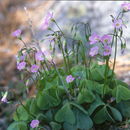en
names in breadcrumbs


Oxalis violacea, the violet wood-sorrel, is a perennial plant and herb in the family Oxalidaceae.[1] It is native to the eastern and central United States.
Oxalis violacea emerges in early spring from an underground bulb and produces leaf stems 7–13 cm (2+3⁄4–5 in) tall and flower umbels, or clusters, with up to 19 flowers on stems 9–23 cm (3+1⁄2–9 in) tall.[2] The three-part leaves have heart-shaped leaflets. The plant is similar in appearance to small clovers such as the shamrock.
The plant bears lavender to white flowers 1–2 cm (1⁄2–3⁄4 in) wide with white to pale green centers above the foliage, during April or May, rarely to July, and, with rain, sometimes produces additional flowers without leaves from August to October.[2]
The genus name, Oxalis, is from the Greek word oxys, which means "sharp" and refers to the sharp or sour taste from the oxalic acid present in the plant.[3][4] The specific epithet, violacea, is Latin for violet-colored.[5]
It is native plant in much of the United States, from the Rocky Mountains east to the Atlantic Ocean and Gulf of Mexico coasts, and through Eastern Canada. It has a tendency to cluster in open places in damp woods and on stream banks, and in moist prairies.[1]
The plant's conservation status is globally secure;[6] however, it is listed as endangered in Massachusetts[7] and Rhode Island,[8] threatened in New York,[9] and a species of special concern in Connecticut.[10] It is presumed extirpated in Michigan.[11]
Oxalis violacea was used as a medicinal plant by Native Americans, including the Cherokee and Pawnee peoples.[12]
All parts of the plant are edible – flowers, leaves, stems, and bulb. Oxalis is from the Greek word meaning sour, and this plant has a sour juice. It is used in salads. Moderate use of plant is advisable, as it should not be eaten in large quantities due to a high concentration of oxalic acid, ("salt of lemons") which can be poisonous.[13]
It was a traditional food source of the Native American Apache, Cherokee, Omaha, Pawnee, and Ponca peoples.[12]
Oxalis violacea is cultivated as an ornamental plant, for use as a flowering groundcover or perennial plant in traditional and native plant gardens, and for natural landscaping projects.[14] It spreads rapidly by runners and bulbs.[15] In gardens the plant prefers partial shade and moisture.[15]
Oxalis violacea, the violet wood-sorrel, is a perennial plant and herb in the family Oxalidaceae. It is native to the eastern and central United States.